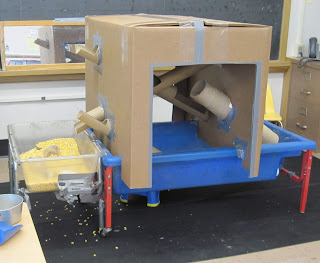I saw this primarily as a large muscle apparatus that made children get down on their hands and knees to crawl through. Of course it was much more than that, but I set it up for children to find ways to inhabit a space inside the boxes
After the fort, I would move the big boxes over to the sensory table. Again the idea was for children to crawl into the boxes and play in the sensory table from the space inside the boxes.
However, there have been several big box constructions that were not specifically made for children to go in. An example was the Big box on top. I set a large box over the top of the sensory table and embedded several cardboard tubes through it.
I am not sure why, but one child saw it as an invitation to actually crawl into the table under the box among all the tubes. What was it about this apparatus that said to the child "come on in?"
Of course, if it was an invitation for one child to experience the enclosed space, surely it was an invitation for others to join her.
Eventually four children ended up in the table under the big box. It was so crowded that any movement set off a chain reaction of children squirming inside the box. The box both contained and restricted their whole body play and offered the children an intimate experience in spatial and personal relations.
I eventually embedded another cardboard tube as an experiment to see if that would prevent children from crawling into the table under the box.
It did not. I suppose I could have added even more tubes through the box, but the children demonstrated their propensity to inhabit spaces like this.
I was not surprised then when children crawled into the box of another apparatus that was the sensory
I actually partially embedded the sensory table into a large box. One child (above) crawled into the box from the table. He then crawled out of the table into the space next to the table that was still inside the box. He was pleased with his little journey, a journey made possible by the very nature of the construction.
For others, it was not a journey, but an enclosed space in which to work. In the picture below, two children crawled into the space in between the box and the table. The space both constricted and defined their play. For instance, these two children were older and bigger so they were forced to work from a kneeling position.
Below is one more example of an apparatus that beckoned children to experience it from the inside. I called it Big box big windows
Two children crawled into the larger box through the large side windows. These two sat comfortably inside pouring and filling their containers.
I have always said that children are masters at exploring space. What may be just as important is the idea that spaces themselves play an active part in those explorations. Even though all three examples show children working inside a big box structure, each has a different energy and rhythm depending partly on the construction itself. If I try to imagine the sensory table without these constructions, the play would necessarily be different; there would not be the beauty and creativity of "thinking inside the box."


















































